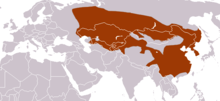Asiatic badger
| Asiatic badger | ||||||||||||
|---|---|---|---|---|---|---|---|---|---|---|---|---|

Asiatic badger specimen on display in the Kunming Natural History Museum of Zoology, China |
||||||||||||
| Systematics | ||||||||||||
|
||||||||||||
| Scientific name | ||||||||||||
| Meles leucurus | ||||||||||||
| ( Hodgson , 1847) |
The Asian badger ( Meles leucurus ) is a predator from the family of the Marder and one of four species of the genus Meles , the former in a way were summarized. The distribution of the Asian species extends from the Volga eastwards through the temperate latitudes to East Asia.
description
The Asian badger is about 50–70 cm long and slightly smaller than the European badger . The tail length is between 13 and 20 cm, the weight between 3.5 and 9 kg.
The species is very similar to the European badger, but is overall lighter and shows a lighter, finer head markings. The body is stocky, the legs are short as is the tail. The front paws have strong digging claws, the rear claws are less pronounced. The soles are hairless. The coarse and dense coat is quite long on the top, short, black and less dense underneath. The head shows a characteristic stripe pattern, with two narrow black-brown stripes running over the eyes to the ears on a white background. The tips of the ears are white. The nose is long and trunk-shaped and shows a broad nasal plane . Females carry three pairs of teats. The tooth formula is I 3/3 - C 1/1 - P 3/3 M 1/2 = 34.
Distribution and existence
The distribution area of the Asian badger extends east of the Volga through Central Asia, Mongolia and China to the Korean Peninsula . In the west it borders on the distribution area of the European badger. Between the upper Volga and the Kama there is an area in which both species occur sympatric . The Asian badger is only found west of the Volga in the Schiguli Mountains .
The species is hunted legally and illegally in China, Russia and Mongolia. The IUCN does not consider it to be threatened.
Geographic variation
Two subspecies are recognized.
- M. l. leucurus Hodgson , 1847 - Central, East and South China
- M. l. amurensis Schrenck , 1859 - Northeast China, Korea, Mongolia, Kazakhstan and Russia east of the Volga
Way of life
The way of life is very similar to that of the European badger. More detailed studies of the differences between the species and their way of life are still lacking. The Asian badger is nocturnal and feeds primarily on earthworms and insects . Occasionally, bees or wasps' nests, clutches of birds, carrion or small mammals are added. Depending on what is available over the course of the year, the proportion of plants in the diet can increase significantly. This consists of fruits, nuts and acorns, roots and tubers or arable crops.
The Asian badger is found primarily in richly structured deciduous forests or pastureland with interspersed woody plants, but is also found in mixed and coniferous forests , scrubland, in suburbs of larger cities, in steppes and in semi-deserts. The altitude distribution extends up to 2500 m in the Tian Shan and probably even up to 4000 m in the highlands of Tibet . The species hibernates in the northern parts of the range.
Systematics
Until the end of the 1990s, the Palearctic badger ( Meles meles ; see Distribution of Arctonyx ) was considered the only recent species of the genus Meles . More recent morphological studies of the baculum and molars as well as studies of the mitochondrial DNA have shown that the four subspecies groups described so far each deserve species status. The species was therefore divided into the European badger ( Meles meles ), the Asian badger ( Meles leucurus ), the Transcaucasian badger ( Meles canescens ) and the Japanese badger ( Meles anakuma ).
literature
- Don E. Wilson, Russell A. Mittermeier (Eds.): Handbook of the Mammals of the World. Volume 1: Carnivores. Lynx Edicions, 2009, ISBN 978-84-96553-49-1
Web links
- Meles leucurus in the endangered Red List species the IUCN 2008. Posted by: Abramov, A. & Wozencraft, C., 2008. Accessed March 22, 2011th
- Badger skin
Individual evidence
- ^ A b Don E. Wilson, DeeAnn M. Reeder, et al .: Mammal Species of the World. A Taxonomic and Geographic Reference , 3rd Edition, Johns Hopkins University Press, Baltimore 2005, ISBN 978-0801882210
- ↑ Wilson / Mittermeier (2009), s. literature
- ↑ Alexei V. Abramov: Variation of the baculum structure of the Palearctic badger (Carnivora, Mustelidae, Meles) , Russian Journal of Theriology 1/2002, pp. 57-60, PDF
- ↑ Gennady F. Baryshnikov, Andrey Yu. Puzachenko, Alexei V. Abramov: New analysis of variability of cheek teeth in Eurasian badgers (Carnivora, Mustelidae, Meles) , Russian Journal of Theriology, 2002, 1 (2), pp. 133-149
- ↑ Naoko Kurose, Yayoi Kaneko, Alexei V. Abramov, Boripat Siriaroonrat, Ryuichi Masuda: Low genetic diversity in Japanese populations of the Eurasian badger Meles meles (Mustelidae, Carnivora) revealed by mitochondrial cytochrome b gene sequences . Zoological Science 18, 2001, pp. 1145-1152.
